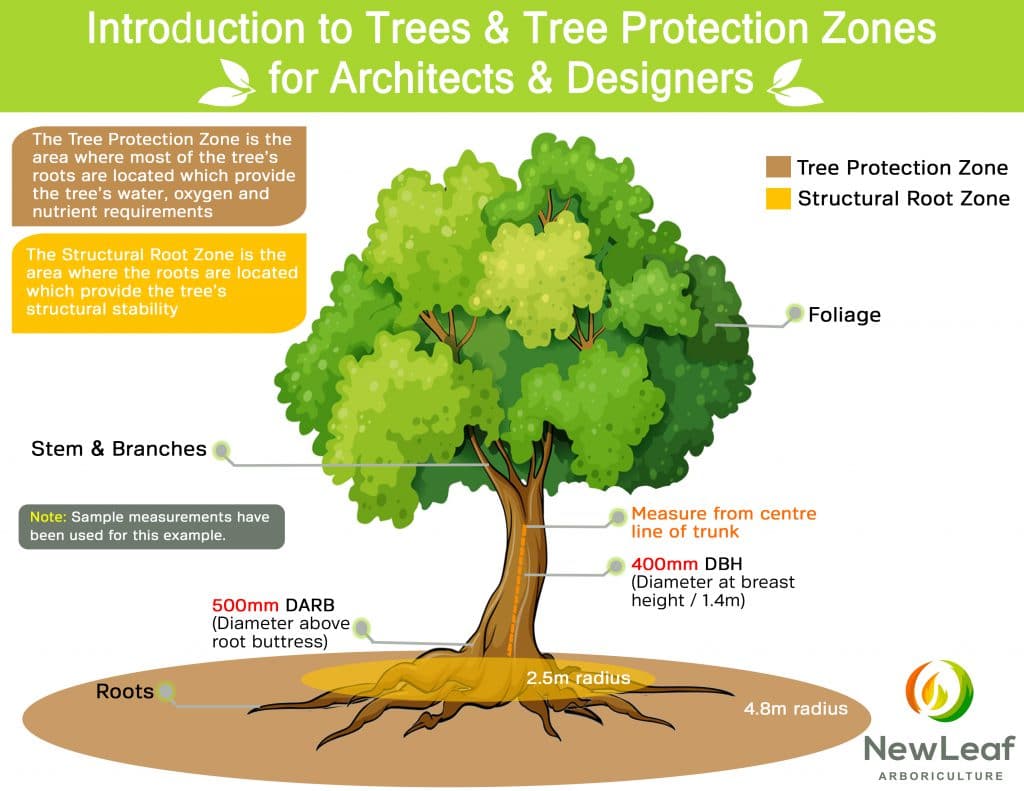Trees are beautiful aesthetic features, but they’re also vital components of our cities and communities. And designing around trees needs to be done carefully, so that they’ll be around for many years to come.
As an arboricultural consultant (and former landscape designer) I understand the value of trees and how we can design around them. This Designing Around Trees series of videos intends to help you as a designer to achieve long, healthy life for trees on your sites when the project is over. And along with each video, I’ll be providing free resources to help you do just that – check the links below to start implementing.
So what’s the deal with trees?
What do they need? How do they work? And what’s design got to do with it?
The three main components of a tree are the foliage, the stem and branches, and the roots. So in this example, the tree has a 400mm DBH (“diameter at breast height” – breast height being 1.4m) and we can calculate the Tree Protection Zone (TPZ) and Structural Root Zone (SRZ) using this measurement (although the SRZ is calculated on the trunk diameter above the root buttress which is often between 10-35% larger than the DBH – your arborist will collect both measurements during their assessment).

Roots absorb water, air and nutrients, and provide structural support
Foliage (leaves) photosynthesise to feed the tree
Trunk and branches transport the water, nutrients and sugars and provide the tree’s structure
Download our Tree Dimensions Cheatsheet to simplify TPZ Calculations!
The Tree Protection Zone
The TPZ is the area of roots that the tree needs to survive – to take in water, oxygen and nutrients to sustain itself and grow. The fibrous or feeder roots are located within this area (and beyond) and this is the zone we need to start with as an exclusion zone when we’re designing, so that the tree can continue to live into the future – and especially during the chaos of construction. And be aware that tree roots generally exist in the top 0.5-1m of soil and often right at the surface. So “minor” features like paving, footings, and landscape works can and do impact tree roots. Download the New Leaf comprehensive list of works that can impact trees to learn more.
The Structural Root Zone
So what are structural roots? They’re the parts of the tree responsible for holding the tree upright and stable – kind of like a footing for a building. But trees are living things, and they need all of their roots, not just the structural roots, to survive. The really important thing to remember is that structural roots don’t grow back. They are the original network of roots starting from the trunk that the tree began its life with, and have grown in response to the tree’s physical and environmental needs for structural stability. The effects of cutting or damaging tree roots may not be apparent until the next storm event, or in many cases, until decay has formed within the root system which weakens the tree’s anchorage. So while trees failing in storms seems like an unpredictable event, it’s often evident that some root damage has happened which contributed to the tree’s instability.
Terms in Tree Management and Arboriculture in Australia
- Tree Protection Zone and Structural Root Zone (NOT Critical Root Zone or Primary Root Zone – those terms are from the British Standard and have been superceded by our own Australian Standard AS4970)
- Tree Removal (not demolition)
- Tree Retention / Trees to be retained
- Pruning is not the same as lopping
Keep an eye out for the next video which will go into site levels and how cut and fill are a crucial consideration when designing around trees!
Download the List of Actions & Works that can Impact Trees
Collab with New Leaf
Let’s work together on your next project – one quick form and you’ll receive a no obligation fee proposal.
